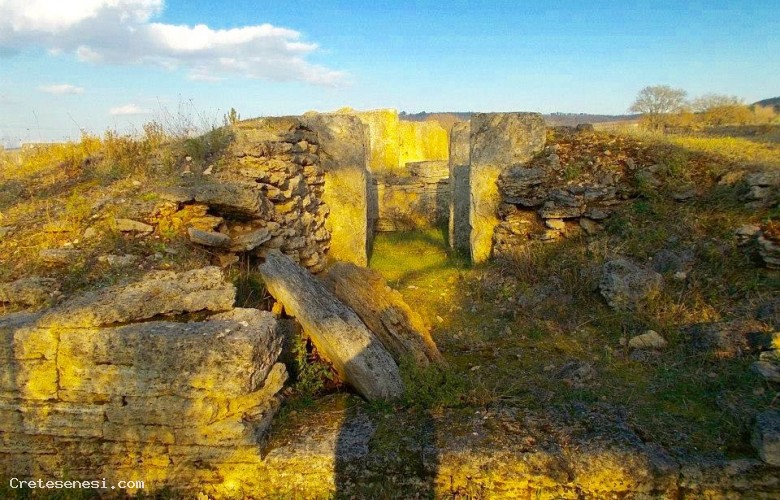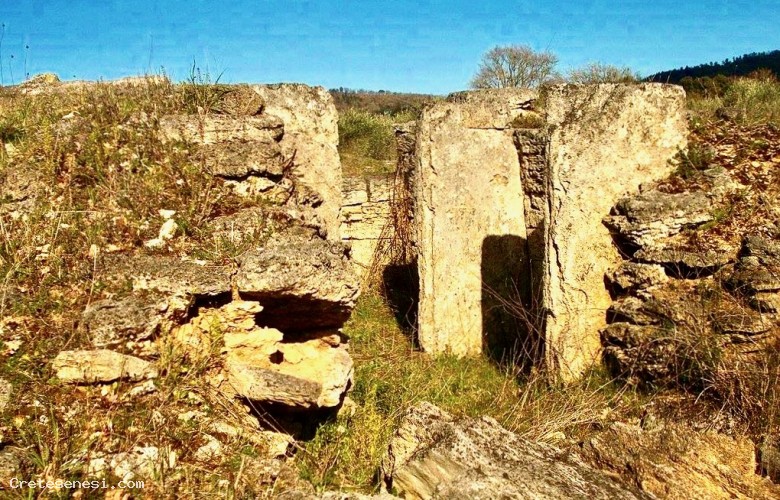Archaeological sites
Tumulo del Molinello
ASCIANO.jpeg)
.jpeg)
.jpeg)

.jpeg)
.jpeg)
.jpeg)
.jpeg)

The discovery of this important Etruscan burial area dates back to 1953, when the farmer of the nearby Il Molinello farm decided to plant some olive trees on a grass-covered hill, close to the house.
While doing the burglary work, immediately under the grass layer he came across squared travertine slabs. The son, who attended elementary school in Asciano, told the matter to maestro Bruno Marignani who, associating the discovery with the fact that the place had always been known as "the hillock of the dead", got in touch with the Carabinieri and, together he made an initial inspection of them.
Having received confirmation that there was a possible archaeological discovery, the area was fenced off and the Superintendency of Siena notified.
Although it was understood that we were faced with an Etruscan burial mound structure, a good 7 years had to pass before the first excavation started, going to investigate only the central part of the mound.
The first excavations in 1960 held several surprises, not all of them positive.
In fact, in addition to precious finds such as a large "married couple" sarcophagus in tufa stone, finely worked and some large travertine statues still partially colored, a metal shovel was also found, one of those used by the German army, from the Second World War.
The confirmation of the desecration of the tomb during the war was dramatically confirmed by the decapitation of the head of the statues and the lid of the great sarcophagus. Evidently, someone had discovered the tomb well before 1953 and, not being able to take away the entire funerary equipment, had limited himself to removing the smallest things, considered precious.
Despite the disastrous looting carried out in haste during the conflict, the complete excavation of the central tomb, carried out in 1960, brought to light many finds which, to be studied and restored, were transferred to Florence at the archaeological museum of Tuscany.
Work on the other 14 chamber tombs identified resumed only in 1983 and currently it seems that there is still one left to be excavated, because it was judged of little interest.
The many important finds recovered were all sent to Florence for recomposition and restoration and, only around the year 2000, were they added to the collection of objects housed in the local Etruscan Museum. Museum built at the end of the 1960s, in the former church of San Bernardino, exhibiting the finds from the Necropolis of Poggio Pinci.
Only in 2002 did the material from the necropolis of Poggio Pinci and that from the Tumulo del Mulinello find an adequate definitive location within the newly built Civic Museum of Palazzo Corboli.
The discovery of this important Etruscan burial area dates back to 1953, when the farmer of the nearby Il Molinello farm decided to plant some olive trees on a grass-covered hill, close to the house.
While doing the burglary work, immediately under the grass layer he came across squared travertine slabs. The son, who attended elementary school in Asciano, told the matter to maestro Bruno Marignani who, associating the discovery with the fact that the place had always been known as "the hillock of the dead", got in touch with the Carabinieri and, together he made an initial inspection of them.
Having received confirmation that there was a possible archaeological discovery, the area was fenced off and the Superintendency of Siena notified.
Although it was understood that we were faced with an Etruscan burial mound structure, a good 7 years had to pass before the first excavation started, going to investigate only the central part of the mound.
The first excavations in 1960 held several surprises, not all of them positive.
In fact, in addition to precious finds such as a large "married couple" sarcophagus in tufa stone, finely worked and some large travertine statues still partially colored, a metal shovel was also found, one of those used by the German army, from the Second World War.
The confirmation of the desecration of the tomb during the war was dramatically confirmed by the decapitation of the head of the statues and the lid of the great sarcophagus. Evidently, someone had discovered the tomb well before 1953 and, not being able to take away the entire funerary equipment, had limited himself to removing the smallest things, considered precious.
Despite the disastrous looting carried out in haste during the conflict, the complete excavation of the central tomb, carried out in 1960, brought to light many finds which, to be studied and restored, were transferred to Florence at the archaeological museum of Tuscany.
Work on the other 14 chamber tombs identified resumed only in 1983 and currently it seems that there is still one left to be excavated, because it was judged of little interest.
The many important finds recovered were all sent to Florence for recomposition and restoration and, only around the year 2000, were they added to the collection of objects housed in the local Etruscan Museum. Museum built at the end of the 1960s, in the former church of San Bernardino, exhibiting the finds from the Necropolis of Poggio Pinci.
Only in 2002 did the material from the necropolis of Poggio Pinci and that from the Tumulo del Mulinello find an adequate definitive location within the newly built Civic Museum of Palazzo Corboli.